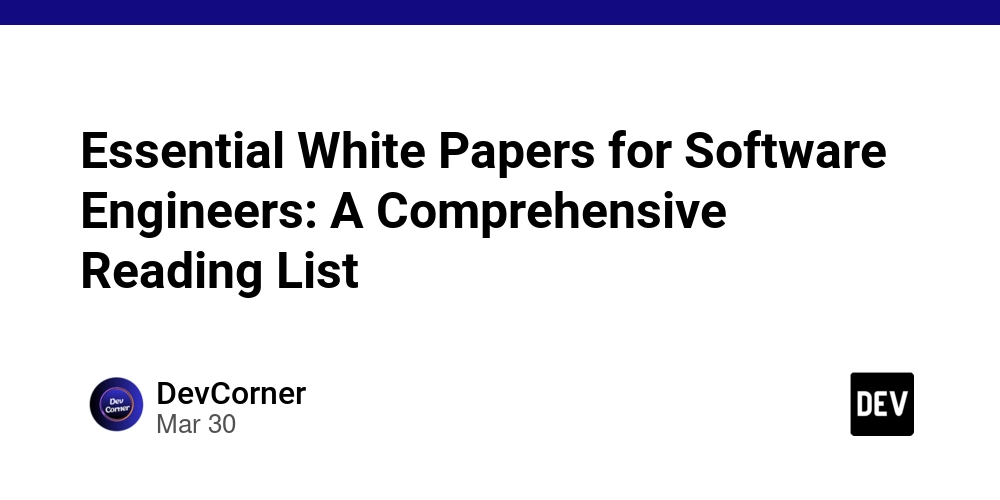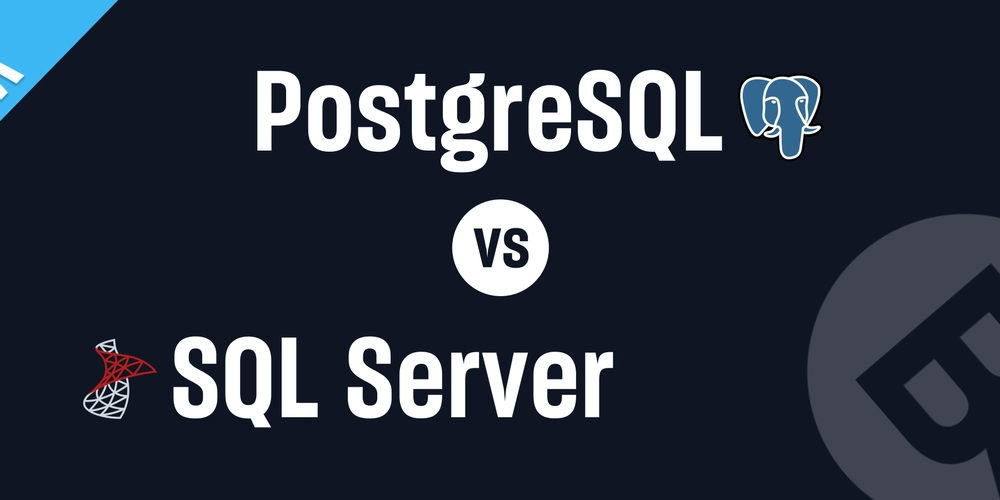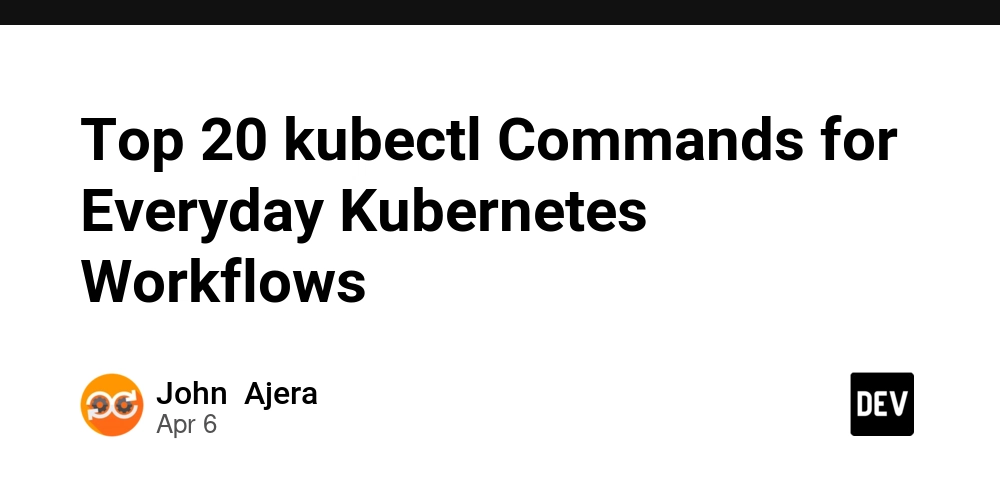Essential White Papers for Software Engineers: A Comprehensive Reading List
As software engineering continues to evolve at a rapid pace, staying informed about fundamental concepts, architectural patterns, and breakthrough technologies is crucial for professional growth. White papers—technical documents that provide deep insights into research findings, system architectures, and design principles—serve as the backbone of our technical knowledge. This comprehensive list brings together the most influential white papers across various domains of software engineering. Whether you're a junior developer looking to build your foundation or a seasoned engineer aiming to deepen your expertise, these papers offer invaluable insights that have shaped our industry. Distributed Systems Foundational Concepts "Fallacies of Distributed Computing Explained" by Arnon Rotem-Gal-Oz (2006) Read the paper A practical explanation of the eight fallacies of distributed computing originally coined by Peter Deutsch. "A Note on Distributed Computing" by Jim Waldo, Geoff Wyant, Ann Wollrath, and Sam Kendall (1994) Read the paper This paper explains why distributed objects should not be treated like local objects, challenging the notion that distribution can be transparent. "Time, Clocks, and the Ordering of Events in a Distributed System" by Leslie Lamport (1978) Read the paper Introduces the concept of logical clocks and partial ordering of events in distributed systems, fundamental to understanding distributed algorithms. Storage Systems "The Google File System" by Sanjay Ghemawat, Howard Gobioff, and Shun-Tak Leung (2003) Read the paper Describes the architecture of Google's distributed file system designed for large-scale data processing needs. "Dynamo: Amazon's Highly Available Key-value Store" by Giuseppe DeCandia et al. (2007) Read the paper Details the design of Amazon's eventually consistent key-value store that sacrifices consistency under certain failure scenarios for availability. "Bigtable: A Distributed Storage System for Structured Data" by Fay Chang et al. (2006) Read the paper Describes Google's distributed storage system for managing structured data at scale. Processing Frameworks "MapReduce: Simplified Data Processing on Large Clusters" by Jeffrey Dean and Sanjay Ghemawat (2004) Read the paper Introduces the MapReduce programming model for processing and generating large datasets with a parallel, distributed algorithm. "The Dataflow Model: A Practical Approach to Balancing Correctness, Latency, and Cost in Massive-Scale, Unbounded, Out-of-Order Data Processing" by Tyler Akidau et al. (2015) Read the paper Presents the dataflow model used in Google's Cloud Dataflow and Apache Beam for processing unbounded and bounded data. Consensus Algorithms "Paxos Made Simple" by Leslie Lamport (2001) Read the paper A simplified explanation of the Paxos consensus algorithm, which enables distributed systems to agree on values. "In Search of an Understandable Consensus Algorithm (Extended Version)" by Diego Ongaro and John Ousterhout (2014) Read the paper Introduces the Raft consensus algorithm, designed to be more understandable than Paxos while providing the same functionality. Software Architecture & Design "On the Criteria To Be Used in Decomposing Systems into Modules" by David Parnas (1972) Read the paper Establishes the concept of information hiding and encapsulation in modular design. "A Design Methodology for Reliable Software Systems" by Barbara Liskov (1972) Read the paper Introduces the concept of abstract data types and modular programming. "The UNIX Time-Sharing System" by Dennis Ritchie and Ken Thompson (1974) Read the paper Describes the design philosophy behind UNIX, emphasizing simplicity and modular design. "Architectural Styles and the Design of Network-based Software Architectures" by Roy Fielding (2000) Read the paper Introduces and defines REST (Representational State Transfer) as an architectural style for networked systems. "End-To-End Arguments in System Design" by J.H. Saltzer, D.P. Reed, and D.D. Clark (1984) Read the paper Presents the end-to-end principle, which suggests that certain functions should be implemented at the endpoints of a system. Database Systems "ACID Properties of Transactions" by Theo Haerder and Andreas Reuter (1983) Read the paper Introduces the ACID properties that guarantee reliable processing of database transactions. "A Relational Model of Data for Large Shared Data Banks" by E.F. Codd (1970) Read the paper Introduces the relational model for database management, which forms the basis of SQL databases. "Spanner: Google's Globally-Distributed Database" by James C. Corbett et al. (2012) Read the paper Describes Google's globally distributed database that provides externally consistent transactions. "The Design and Implementation of Modern Column-Oriented Database Systems" by Daniel Abadi et al. (2012) Read the paper A comprehensive survey of column-oriented data

As software engineering continues to evolve at a rapid pace, staying informed about fundamental concepts, architectural patterns, and breakthrough technologies is crucial for professional growth. White papers—technical documents that provide deep insights into research findings, system architectures, and design principles—serve as the backbone of our technical knowledge.
This comprehensive list brings together the most influential white papers across various domains of software engineering. Whether you're a junior developer looking to build your foundation or a seasoned engineer aiming to deepen your expertise, these papers offer invaluable insights that have shaped our industry.
Distributed Systems
Foundational Concepts
"Fallacies of Distributed Computing Explained" by Arnon Rotem-Gal-Oz (2006)
Read the paper
A practical explanation of the eight fallacies of distributed computing originally coined by Peter Deutsch."A Note on Distributed Computing" by Jim Waldo, Geoff Wyant, Ann Wollrath, and Sam Kendall (1994)
Read the paper
This paper explains why distributed objects should not be treated like local objects, challenging the notion that distribution can be transparent."Time, Clocks, and the Ordering of Events in a Distributed System" by Leslie Lamport (1978)
Read the paper
Introduces the concept of logical clocks and partial ordering of events in distributed systems, fundamental to understanding distributed algorithms.
Storage Systems
"The Google File System" by Sanjay Ghemawat, Howard Gobioff, and Shun-Tak Leung (2003)
Read the paper
Describes the architecture of Google's distributed file system designed for large-scale data processing needs."Dynamo: Amazon's Highly Available Key-value Store" by Giuseppe DeCandia et al. (2007)
Read the paper
Details the design of Amazon's eventually consistent key-value store that sacrifices consistency under certain failure scenarios for availability."Bigtable: A Distributed Storage System for Structured Data" by Fay Chang et al. (2006)
Read the paper
Describes Google's distributed storage system for managing structured data at scale.
Processing Frameworks
"MapReduce: Simplified Data Processing on Large Clusters" by Jeffrey Dean and Sanjay Ghemawat (2004)
Read the paper
Introduces the MapReduce programming model for processing and generating large datasets with a parallel, distributed algorithm."The Dataflow Model: A Practical Approach to Balancing Correctness, Latency, and Cost in Massive-Scale, Unbounded, Out-of-Order Data Processing" by Tyler Akidau et al. (2015)
Read the paper
Presents the dataflow model used in Google's Cloud Dataflow and Apache Beam for processing unbounded and bounded data.
Consensus Algorithms
"Paxos Made Simple" by Leslie Lamport (2001)
Read the paper
A simplified explanation of the Paxos consensus algorithm, which enables distributed systems to agree on values."In Search of an Understandable Consensus Algorithm (Extended Version)" by Diego Ongaro and John Ousterhout (2014)
Read the paper
Introduces the Raft consensus algorithm, designed to be more understandable than Paxos while providing the same functionality.
Software Architecture & Design
"On the Criteria To Be Used in Decomposing Systems into Modules" by David Parnas (1972)
Read the paper
Establishes the concept of information hiding and encapsulation in modular design."A Design Methodology for Reliable Software Systems" by Barbara Liskov (1972)
Read the paper
Introduces the concept of abstract data types and modular programming."The UNIX Time-Sharing System" by Dennis Ritchie and Ken Thompson (1974)
Read the paper
Describes the design philosophy behind UNIX, emphasizing simplicity and modular design."Architectural Styles and the Design of Network-based Software Architectures" by Roy Fielding (2000)
Read the paper
Introduces and defines REST (Representational State Transfer) as an architectural style for networked systems."End-To-End Arguments in System Design" by J.H. Saltzer, D.P. Reed, and D.D. Clark (1984)
Read the paper
Presents the end-to-end principle, which suggests that certain functions should be implemented at the endpoints of a system.
Database Systems
"ACID Properties of Transactions" by Theo Haerder and Andreas Reuter (1983)
Read the paper
Introduces the ACID properties that guarantee reliable processing of database transactions."A Relational Model of Data for Large Shared Data Banks" by E.F. Codd (1970)
Read the paper
Introduces the relational model for database management, which forms the basis of SQL databases."Spanner: Google's Globally-Distributed Database" by James C. Corbett et al. (2012)
Read the paper
Describes Google's globally distributed database that provides externally consistent transactions."The Design and Implementation of Modern Column-Oriented Database Systems" by Daniel Abadi et al. (2012)
Read the paper
A comprehensive survey of column-oriented database systems and their advantages for analytical workloads.
Programming Languages & Paradigms
"Why Functional Programming Matters" by John Hughes (1989)
Read the paper
Explains the importance of higher-order functions and lazy evaluation in functional programming."On Understanding Types, Data Abstraction, and Polymorphism" by Luca Cardelli and Peter Wegner (1985)
Read the paper
A foundational paper on type systems and polymorphism in programming languages."Communicating Sequential Processes" by C.A.R. Hoare (1978)
Read the paper
Introduces CSP, a formal language for describing patterns of interaction in concurrent systems."Go To Statement Considered Harmful" by Edsger W. Dijkstra (1968)
Read the paper
Argues against the use of the GOTO statement and advocates for structured programming.
Security & Cryptography
"The Protection of Information in Computer Systems" by Jerome Saltzer and Michael Schroeder (1975)
Read the paper
Introduces many security design principles that remain relevant today, including the principle of least privilege."Bitcoin: A Peer-to-Peer Electronic Cash System" by Satoshi Nakamoto (2008)
Read the paper
Introduces the concept of blockchain and the Bitcoin cryptocurrency."A Method for Obtaining Digital Signatures and Public-Key Cryptosystems" by Rivest, Shamir, and Adleman (1978)
Read the paper
Introduces the RSA algorithm for public-key cryptography."New Directions in Cryptography" by Whitfield Diffie and Martin Hellman (1976)
Read the paper
Introduces the concept of public-key cryptography and the Diffie-Hellman key exchange.
Artificial Intelligence & Machine Learning
"Attention Is All You Need" by Ashish Vaswani et al. (2017)
Read the paper
Introduces the Transformer architecture that revolutionized natural language processing."ImageNet Classification with Deep Convolutional Neural Networks" by Alex Krizhevsky, Ilya Sutskever, and Geoffrey Hinton (2012)
Read the paper
Introduces AlexNet, which revolutionized computer vision with deep convolutional neural networks."Distributed Representations of Words and Phrases and their Compositionality" by Tomas Mikolov et al. (2013)
Read the paper
Introduces the word2vec model for learning word embeddings."Deep Residual Learning for Image Recognition" by Kaiming He et al. (2015)
Read the paper
Introduces ResNet architecture with skip connections, enabling training of much deeper neural networks.
Software Engineering Practices
"A Rational Design Process: How and Why to Fake It" by David L. Parnas and Paul C. Clements (1986)
Read the paper
Argues that while a completely rational design process is not achievable, we should document our systems as if we had followed one."No Silver Bullet — Essence and Accident in Software Engineering" by Frederick P. Brooks Jr. (1986)
Read the paper
Argues that there is no single development, in either technology or management technique, that can solve the essential problems of software engineering."A Plea for Lean Software" by Niklaus Wirth (1995)
Read the paper
Argues against the growing complexity of software and advocates for lean, efficient design."Out of the Tar Pit" by Ben Moseley and Peter Marks (2006)
Read the paper
Analyzes the causes of software complexity and proposes functional programming and formal specification as solutions.
Networking & Web Technologies
"The Web's Grain" by Frank Chimero (2015)
Read the essay
An essay about working with the inherent nature of the web as a medium."Representational State Transfer (REST)" by Roy Fielding (Chapter 5 of dissertation, 2000)
Read the chapter
Defines the REST architectural style for distributed hypermedia systems."TCP/IP Architecture, Design, and Implementation in Linux" by Sameer Seth and M. Ajaykumar Venkatesulu (2008)
Read about the book
A comprehensive look at the TCP/IP implementation in Linux, valuable for understanding networking fundamentals.
System Design & Scalability
"Harvest, Yield, and Scalable Tolerant Systems" by Armando Fox and Eric A. Brewer (1999)
Read the paper
Introduces the CAP theorem, which states that distributed systems can only guarantee two out of three properties: consistency, availability, and partition tolerance."The Chubby Lock Service for Loosely-Coupled Distributed Systems" by Mike Burrows (2006)
Read the paper
Describes Google's distributed lock service used for synchronizing access to shared resources."Designing Data-Intensive Applications" by Martin Kleppmann (2017)
Book information
While not a traditional white paper, this book has become a staple reference for designing scalable, reliable, and maintainable applications.
Human-Computer Interaction
"A Brief History of Human-Computer Interaction Technology" by Brad A. Myers (1998)
Read the paper
Provides an overview of the development of human-computer interaction technologies."The Design of Everyday Things" by Don Norman (1988)
Book information
A classic book that introduces fundamental principles of usable design.
Cloud Computing & DevOps
"Above the Clouds: A Berkeley View of Cloud Computing" by Michael Armbrust et al. (2009)
Read the paper
Defines cloud computing and discusses its economic and technical aspects."The Twelve-Factor App" by Adam Wiggins (2011)
Read the methodology
A methodology for building software-as-a-service applications that are optimized for modern cloud environments."Chaos Engineering: Building Confidence in System Behavior through Experiments" by Ali Basiri et al. (2016)
Read the paper
Introduces the principles and practices of chaos engineering for improving system resilience.
Emerging Technologies
"Quantum Computing: Progress and Prospects" by the National Academies of Sciences, Engineering, and Medicine (2019)
Read the report
A comprehensive overview of the state of quantum computing and its potential applications."The Computer for the 21st Century" by Mark Weiser (1991)
Read the paper
Introduces the concept of ubiquitous computing, envisioning computing devices integrated into everyday objects.
How to Approach Reading White Papers
Reading technical white papers can be intimidating, but the following approach can help:
- Start with the abstract and conclusion to understand the main goals and findings.
- Skim through the entire paper to get familiar with its structure and content.
- Read the introduction and related work to understand the context and problem statement.
- Focus on sections most relevant to your interests or current work.
- Create visual representations of complex concepts to aid understanding.
- Discuss with peers to gain different perspectives and deepen your understanding.
- Apply the concepts in small projects to reinforce learning.
Continuous Learning Resources
To stay updated with the latest research and white papers:
- Papers We Love: A GitHub repository of computer science papers and a community of software engineers who appreciate academic research.
- arXiv.org: A repository of electronic preprints of scientific papers in various fields, including computer science.
- ACM Digital Library: A comprehensive collection of articles, conference proceedings, and journals in computing.
- IEEE Xplore: A digital library providing access to technical literature in engineering and technology.
- The Morning Paper: A blog by Adrian Colyer that provides accessible summaries of important computer science papers.
Conclusion
These white papers represent the foundation upon which modern software engineering is built. By studying them, you gain not just knowledge of specific technologies, but a deeper understanding of the principles, patterns, and trade-offs that shape our field.
Remember that reading white papers is not just an academic exercise—it's about developing a mental model that can inform your daily engineering decisions and help you build more robust, efficient, and maintainable systems.
Happy reading!












































































































































































![[The AI Show Episode 142]: ChatGPT’s New Image Generator, Studio Ghibli Craze and Backlash, Gemini 2.5, OpenAI Academy, 4o Updates, Vibe Marketing & xAI Acquires X](https://www.marketingaiinstitute.com/hubfs/ep%20142%20cover.png)



























































































































![[DEALS] The Premium Learn to Code Certification Bundle (97% off) & Other Deals Up To 98% Off – Offers End Soon!](https://www.javacodegeeks.com/wp-content/uploads/2012/12/jcg-logo.jpg)


![From drop-out to software architect with Jason Lengstorf [Podcast #167]](https://cdn.hashnode.com/res/hashnode/image/upload/v1743796461357/f3d19cd7-e6f5-4d7c-8bfc-eb974bc8da68.png?#)








































































































.png?#)

































_Christophe_Coat_Alamy.jpg?#)
 (1).webp?#)





































































































![Apple Considers Delaying Smart Home Hub Until 2026 [Gurman]](https://www.iclarified.com/images/news/96946/96946/96946-640.jpg)
![iPhone 17 Pro Won't Feature Two-Toned Back [Gurman]](https://www.iclarified.com/images/news/96944/96944/96944-640.jpg)
![Tariffs Threaten Apple's $999 iPhone Price Point in the U.S. [Gurman]](https://www.iclarified.com/images/news/96943/96943/96943-640.jpg)




































































































































